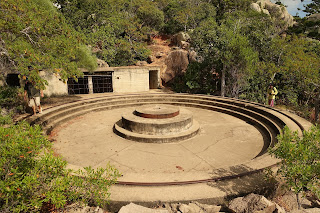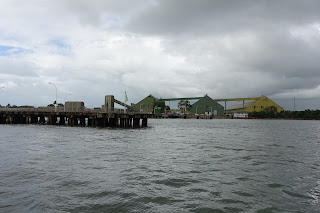 |
| Matilda bound for Orpheus Island |
Spending the last week or so at Magnetic Island with Sally and Forfar was so much fun. We did the Fort Walk together and spent many hours discussing Indonesia and beyond on our boats. It was so good being able to banter back and forth with concerns and to hear what others are doing - it was all very interesting and we learnt lots. We were glad to finally have our first aid kit sorted with their expertise and advice.
The Fort Walk was amazing and nothing like what i thought it was going to be. The walk and bus ride back took most of the day and it wasn't too grueling. It was amazing how they put all this in place in such a remote area. Bruce and I also enjoyed the only bus circuit on the Island as it took us on a tour. We stopped off at the other side of the island for a look see which was beautiful. Both of us are very much looking forward to going back one day and exploring more of the many bays Magnetic Island has to offer.
A weather window presented itself on Thursday 5th of May to enjoy a day sail to Orpheus Island so we took it. We enjoyed a 9 hr sail and dropped the anchor in Little Pioneer Bay with Squander. None of us where in a hurry so we all decided to spend a couple of days exploring and relaxing. The next day we went ashore for a walk but in thongs we couldn't get far. A timely reminder for us to invest in good sturdy walking shoes/sandals. The following day we enjoyed a snorkel and got to see some pretty coral and a few fish but visibility was low.
 |
| The sun setting behind Matilda over Hinchinbrook Island. |
The next morning we left Reis Point and motored a bit more up the channel and dropped anchor at Scraggy Point. We went ashore here and found the fresh water creek - it was beautiful. However the mosquitoes where in there thousands yet again, and unfortunately the crocs were still in hiding When we headed ashore for our walk we were able to look over some fish traps built in the shallows. 

Next day we motored again out of the channel and over to Goold Island. We made good time and decided to go for a walk and even enjoyed a little swim.
Dunk Island was next on the agenda and this was also a very light days sailing only taking 4 hours. We spent the next day at anchor doing some boat maintenance. Unfortunately my left knee is swelling up so a days rest seemed to make sense, however it meant we didn't get a chance to go ashore which was a real shame. The view from the boat was a bit heart breaking to see how the once pristine resort was still damaged from cyclone Yasi that made land fall on the 3 February 2011.While the owners have made progress there is still a way to go before it becomes any where near the resort it once was.
Friday the 13th seemed an ominous day to set sail but we did as the winds were again in our favor. Another short days sail only taking 4 hours all up to Mourilyn Harbour. Much to our delight we caught a tuna on the journey up. Not being overly fussed on tuna we wanted to give it to Sally and Forfar and we used the frame for bait and dropped a crab pot in but it didn't reward us with much, At least Bruce got to practice his rowing skills!
 |
| Mourilyn Harbour |
 |
| Matilda sailing up Trinity Inlet - Cairns |
As I write this blog its the end of the month and we have not stopped. Every day we seemed to be either ashore gathering supplies and hemorrhaging our bank balance or on board tackling the endless 'to do' list of maintenance and improvements we have deemed necessary before we leave Cairns and leave Australia. Lucky for us Bruce is very hands on and works tirelessly on his beloved Matilda.
 |
| Bruce yet again in a tight spot. This time working on the toilet pump. |
 |
| Erica, Charlie, Bruce & Deb at the Salt House. |
The Sail2Indonesia rally must is not far off now. We are surprised that only 2 (one being us) boats out of 34 are in the inlet. Maybe they are much more relaxed and organised than us! We have been down in the tender to the Cairns Cruising Yacht Squadron, which is down past the navy base in Smiths Creek. Its a long way in the tender and glad that the rally organizers have arranged a bus to pick participants up in and run them around.
 |
| Friends arriving to join the rally. |
 |
| Super yacht - Ethereal |
 |
| Ethereal at night. |
The Great Dividing Range is impressive. It completely surrounds Cairns and the clouds love to cling to the forest giving it all a look that's hard to describe - its very, very impressive. Its hot here too, the humidity has knocked us about a bit and we need to learn to do four things: slow down, rest, don't run around in the middle of the day and drink loads of water. Lessons we are learning quickly.
Some days we are lucky to catch the sun setting. This is an inspiring sight with colours that fill the sky. A great reminder we are in Far North Queensland.











































